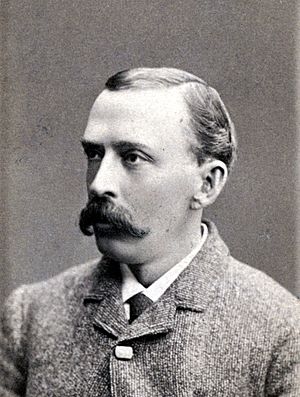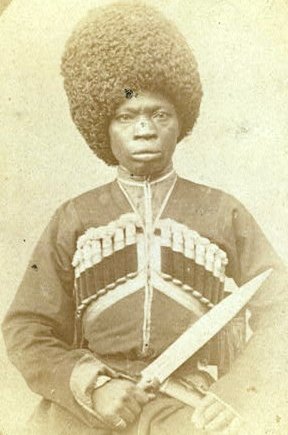George Kennan (explorer) facts for kids
Quick facts for kids
George Kennan
|
|
|---|---|

George Kennan - photo from 1885
|
|
| Born | February 16, 1845 Norwalk, Ohio, United States
|
| Died | May 10, 1924 (aged 79) Medina, New York, United States
|
| Resting place | Boxwood Cemetery |
| Nationality | American |
| Occupation | Journalist, war correspondent |
| Years active | 1878–1924 |
| Signature | |
George Kennan (born February 16, 1845 – died May 10, 1924) was an American explorer and journalist. He became famous for his exciting trips to faraway places like the Kamchatka and Caucasus regions in the Russian Empire. He was also a distant relative of another famous American, George F. Kennan, who was a diplomat and historian.
Contents
Early Life and First Adventures
George Kennan was born in Norwalk, Ohio. From a young age, he loved the idea of travel and adventure. However, his family didn't have much money. So, at just 12 years old, he started working at a telegraph office for the Cleveland and Toledo Railroad Company.
Exploring Siberia's Wilds
In 1864, George got a job with the Russian–American Telegraph Company. His task was to map out a path for a new telegraph line. This line was planned to go through Siberia and across the Bering Strait. He spent two years exploring the wild lands of Kamchatka. After this amazing journey, he returned to Ohio, traveling through Saint Petersburg. He quickly became well-known by sharing his adventures through talks, articles, and a book.
His book, Tent Life in Siberia, was very important. In it, Kennan wrote about the history and cultures of many native groups in Siberia. These included the Koryaks, Itelmens, Chukchis, Yukaghirs, Chuvans, and Yakuts. His detailed stories are still helpful for researchers today.
Journey to the Caucasus
In 1870, Kennan went back to St. Petersburg. From there, he traveled to Dagestan, a region in the northern Caucasus. The Russian Empire had only taken control of this area ten years earlier. George Kennan was the first American to explore its high mountains. This was a remote area where people were Muslim herders, silversmiths, and carpet-weavers. He continued his journey through the northern Caucasus, visiting places like Samashki and Grozny. He returned to America in 1871. These travels made him known as an "expert" on everything about Russia.
A Career in Journalism
After his travels, Kennan joined the Associated Press in Washington, D.C. in 1878. As a war correspondent, he traveled to many conflict zones around the world. He also wrote articles for popular magazines like Century Magazine, Atlantic Monthly, McClure's Magazine, National Geographic, and The Outlook.
Changing Views on Russia
In May 1885, Kennan started another trip across Siberia from Europe. At first, he openly supported the Russian government and its policies. The Russian government even approved his journey. However, during his travels, he met many people who had been exiled for disagreeing with the government. One important person he met was Nikolai Yadrintsev.
Meeting these dissidents changed Kennan's mind about the Russian imperial system. He was especially moved by Catherine Breshkovsky, a revolutionary leader. She told him, "We may die in exile and our grand children may die in exile, but something will come of it at last." He also met a young Leonid Krasin on this trip.
Speaking Out for Change
When he returned to the United States in August 1886, Kennan became a strong critic of the Russian government. He started to support the idea of a democratic Russia. For the next twenty years, Kennan spent much of his time promoting a Russian revolution, mainly through lectures. He was one of the most active speakers of the late 1800s. He spoke to about a million people during the 1890s. This included 200 talks in a row in 1890–91, often to crowds of up to 2,000 people.
His reports on the harsh conditions in Siberia were published in Century Magazine. In 1891, he released a two-volume book called Siberia and The Exile System. This book included first-hand interviews, facts, and drawings by artist George Albert Frost. It greatly influenced what Americans thought about Russia.
Kennan also became friends with other Russian people living outside Russia, like Peter Kropotkin and Sergei Kravchinskii. He was a well-known member of the Society of Friends of Russian Freedom. This group included famous people like Mark Twain and Julia Ward Howe. He also helped start Free Russia, the first English-language magazine to oppose the Russian government. Because of his strong views, the Russian government banned him from Russia in 1901.
Beyond Russian Matters
Even though he cared deeply about Russia, Kennan also covered other important events. As a reporter, he wrote about American politics, the Spanish–American War, the assassination of President William McKinley, and the Russo-Japanese War. He also covered World War I and the Russian Revolution.
He wrote books about other topics too. One was E. H. Harriman's Far Eastern Plans (1917), about a businessman's efforts to get control of a railway in Japan. Another was The Chicago and Alton Case: A Misunderstood Transaction (1916), where he defended a businessman's purchase of a railroad.
Views on the Russian Revolution
Kennan was strongly against the October Revolution in Russia. He believed the Bolsheviks, who took power, didn't have the "knowledge, experience, or education" to solve the huge problems facing Russia after the Tsar was overthrown. In 1918, President Woodrow Wilson read Kennan's report criticizing the Bolsheviks. However, Kennan later criticized Wilson's government for not doing enough to stop Bolshevism.
Kennan's last criticism of Bolshevism was in a small newspaper, the Medina Tribune, in July 1923. He wrote that the new Bolshevik government still held all the power, and the people could not remove or control them.
Later Life and Passing
George Kennan passed away at his home in Medina, New York, on May 10, 1924. He was buried in Boxwood Cemetery.


